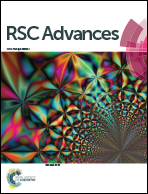Removal of acid red 88 by a magnetic graphene oxide/cationic hydrogel nanocomposite from aqueous solutions: adsorption behavior and mechanism†
Abstract
In this study, a kind of magnetic graphene oxide/cationic hydrogel nanocomposite (MGO–CH) was synthesized and characterized for acid red 88 (AR88) removal. SEM and HRTEM-EDS show that the magnetic graphene oxide nanoparticles were effectively dispersed on the cationic hydrogel matrix. The adsorption kinetics, isotherms, and effects of pH on AR88 uptake by MGO–CH were evaluated. The results show that MGO–CH achieves positive zeta potential values of 35.6–27.8 mV at pH 3.0–10.5, with a saturation magnetization of approximately 4.0 emu g−1. The MGO–CH kinetics show a good fit with the pseudo-second order model. The maximum AR88 adsorption capacity of MGO–CH was 3476.7 mg g−1 at an AR88 equilibrium concentration of 287.4 mg L−1 and pH = 7.0. Equilibrium adsorption data show that the Sips model is more suitable than the Langmuir and Freundlich models. MGO–CH exhibits an AR88 adsorption capacity of more than 1140.2 mg g−1 in a strongly alkaline solution (pH > 10). The adsorption process is highly pH dependent, corresponding to electrostatic interactions, hydrogen bonding, and competitive adsorption interactions, and the optimal adsorption occurs at pH 3.0–5.8. The AR88 adsorption capacity of the regenerated MGO–CH approaches more than 95% of the fresh MGO–CH at a low initial concentration of 100 mg L−1 from the second to fifth recycles. As AR88 initial concentration increased up to 1500 mg L−1, the reusability of MGO–CH was decreased from the first to third cycle and was maintained stably afterwards. Fourier transform infrared spectroscopy reveals that C–O and C![[double bond, length as m-dash]](https://www.rsc.org/images/entities/char_e001.gif) O functional groups contribute to AR88 adsorption. This finding was also confirmed by C 1s spectra from X-ray photoelectron spectroscopy. The deconvolution of the N 1s spectra before and after AR88 adsorption indicates that the quaternary ammonium group of the cationic hydrogel contributes to AR88 removal.
O functional groups contribute to AR88 adsorption. This finding was also confirmed by C 1s spectra from X-ray photoelectron spectroscopy. The deconvolution of the N 1s spectra before and after AR88 adsorption indicates that the quaternary ammonium group of the cationic hydrogel contributes to AR88 removal.


 Please wait while we load your content...
Please wait while we load your content...